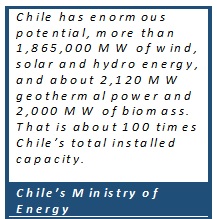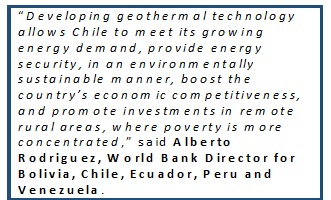News
- Chile’s high geothermal energy potential can help the country diversify its energy mix, reduce electricity price volatility, and improve energy security.
- But the country’s geothermal development potential is still locked due to an array of legal, social and market barriers.
- ESMAP not only helped to mobilize US$50 million through its Global Geothermal Development Plan (GGDP), but also supported an additional US$3 million to directly address these barriers.
What does a country do when it has almost 108 active and dormant volcanoes?
It drills down for steam.
Chile’s abundant geothermal potential provides a good renewable energy option to further diversify the country’s power generation mix – something consistent with Chile’s Energy Policy, which aims for at least 70% of national electricity generation to come from renewable sources by 2050.
Chile has long been the leader of Latin America's renewable energy market. In 2015, investment in renewables, (including small hydropower projects of <50 MW) was around $2.6 billion.
The rate of growth of investment in renewable energy has increased in the past few years, and competition has lowered electricity costs.
 But geothermal energy is lagging. Chile’s only geothermal plant, Cerro Pabellón, which opened earlier this year, is South America’s first operating plant. The Government has tried to develop geothermal energy, but despite a promising start, several issues are preventing further investments in exploration.ESMAP’s Global Geothermal Development Plan (GGDP) was instrumental in mobilizing a US$50 million grant though the Inter-American Development Bank from the Clean Technology Fund (CTF) to stimulate additional investments in the sector. In addition, the CTF approved a grant of US$3 million through the Bank – of which US$1.78 is Bank-executed to provide technical assistance to the government in addressing key legal, social and market barriers and contribute to the development of tradeable geothermal resources.
But geothermal energy is lagging. Chile’s only geothermal plant, Cerro Pabellón, which opened earlier this year, is South America’s first operating plant. The Government has tried to develop geothermal energy, but despite a promising start, several issues are preventing further investments in exploration.ESMAP’s Global Geothermal Development Plan (GGDP) was instrumental in mobilizing a US$50 million grant though the Inter-American Development Bank from the Clean Technology Fund (CTF) to stimulate additional investments in the sector. In addition, the CTF approved a grant of US$3 million through the Bank – of which US$1.78 is Bank-executed to provide technical assistance to the government in addressing key legal, social and market barriers and contribute to the development of tradeable geothermal resources.
In October 2016, renewable energy producers in Chile had won more than a 50% share of Chile’s power tender, with falling costs for renewables driving the average bid price down. This results will have an impact on Chile’s electricity system starting in 2022 and positioning geothermal energy to enter the electricity market will be crucial.
A key aspect of the project is bringing together the government and the geothermal industry to discuss the technical and economic impact of geothermal energy within the unified electricity system in Chile with an increasing intake of non-conventional renewable energy. To ensure that the government and the private sector remained committed to geothermal efforts, ESMAP supported a geothermal roundtable with the objectives of: (i) estimating the cost of geothermal energy in Chile; (ii) analyzing the impact of geothermal energy on the Chilean electricity sector, in the short and long term; and (iii) identifying potential policies to promote geothermal development. The results of the roundtable will be critical for the continued support to geothermal energy in terms of investment and policy.
Another main challenge Chile faces is garnering public support for energy projects. In the past, Chile has relied on imported fossil fuels and hydroelectric plants, sources that have proved  both expensive and unpredictable and expensive in recent years and have been subject to public scrutiny. Communities have increasingly opposed energy projects based on their expected environmental and social impacts. Several large projects have generated public debate and large community protests. Even though geothermal energy could have important benefits, such as help stabilize and secure supply, and minimize environmental and social costs, public trust in its development still needs to be built to move geothermal projects forward.
both expensive and unpredictable and expensive in recent years and have been subject to public scrutiny. Communities have increasingly opposed energy projects based on their expected environmental and social impacts. Several large projects have generated public debate and large community protests. Even though geothermal energy could have important benefits, such as help stabilize and secure supply, and minimize environmental and social costs, public trust in its development still needs to be built to move geothermal projects forward.
ESMAP also supported a study tour where Chilean government officials and indigenous communities visited Nicaragua to learn about the country’s experience with geothermal development. Discussions focused on how those living in geothermal project areas, including indigenous populations, can benefit from industrial services, employment and better connectivity, and other gains associated with the sector’s development. The exchanges with peers helped communities shift their mind-sets about geothermal and support its development.
- To add to this, an ESMAP-funded study helped identify the main barriers to geothermal development and understand the magnitude of the challenge, and aims to help Chile to create a favorable enabling environment to boost investment in the geothermal sector. The study analyzed the measures required to stimulate the geothermal drilling market, with a focus on risk reduction in drilling activities for geothermal developers. The actions identified include:
-
Higher non-conventional renewable energy goals to include higher percentages of geothermal energy before 2025
-
Fiscal incentives in the first phases of project development as well as loan guarantees
-
Risk mitigation funds that provide capital during first phases of project development
-
Direct injection of capital during first phases of project development
-
Cost reductions due to reductions in rig crew and standby days of drilling operations
-
Regulation reform to shorten project development time
-
Increase in human resources in all relevant institutes that handle actions within the regulation processes, such as in the procurement of licenses and developing EIAs
-
Public aid to infrastructure in remote mountain areas
-
Information dissemination to all stakeholders within the geothermal industry, including private developers, the public, regional governments and agencies
Learn more about the ESMAP Renewable Energy Program.
